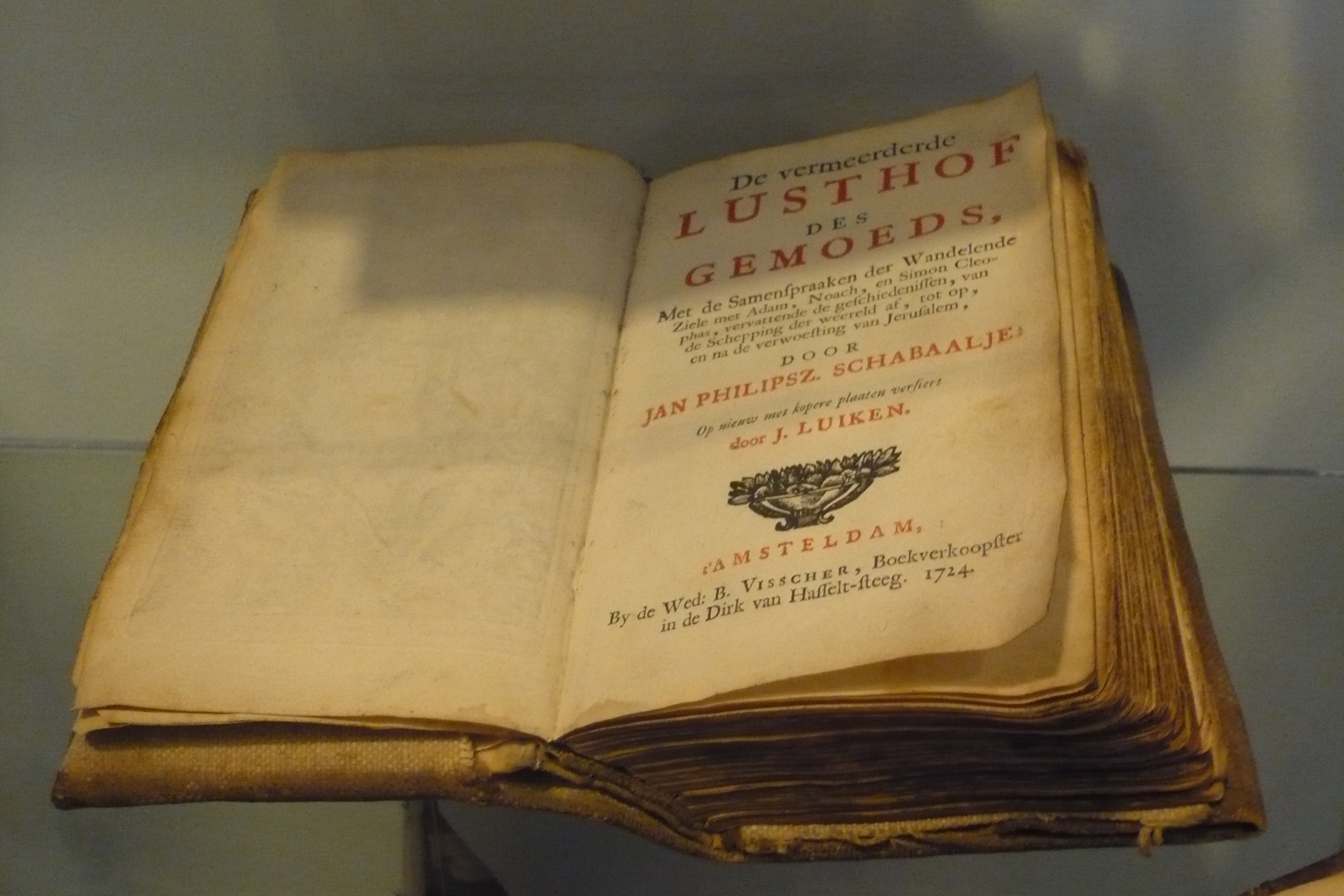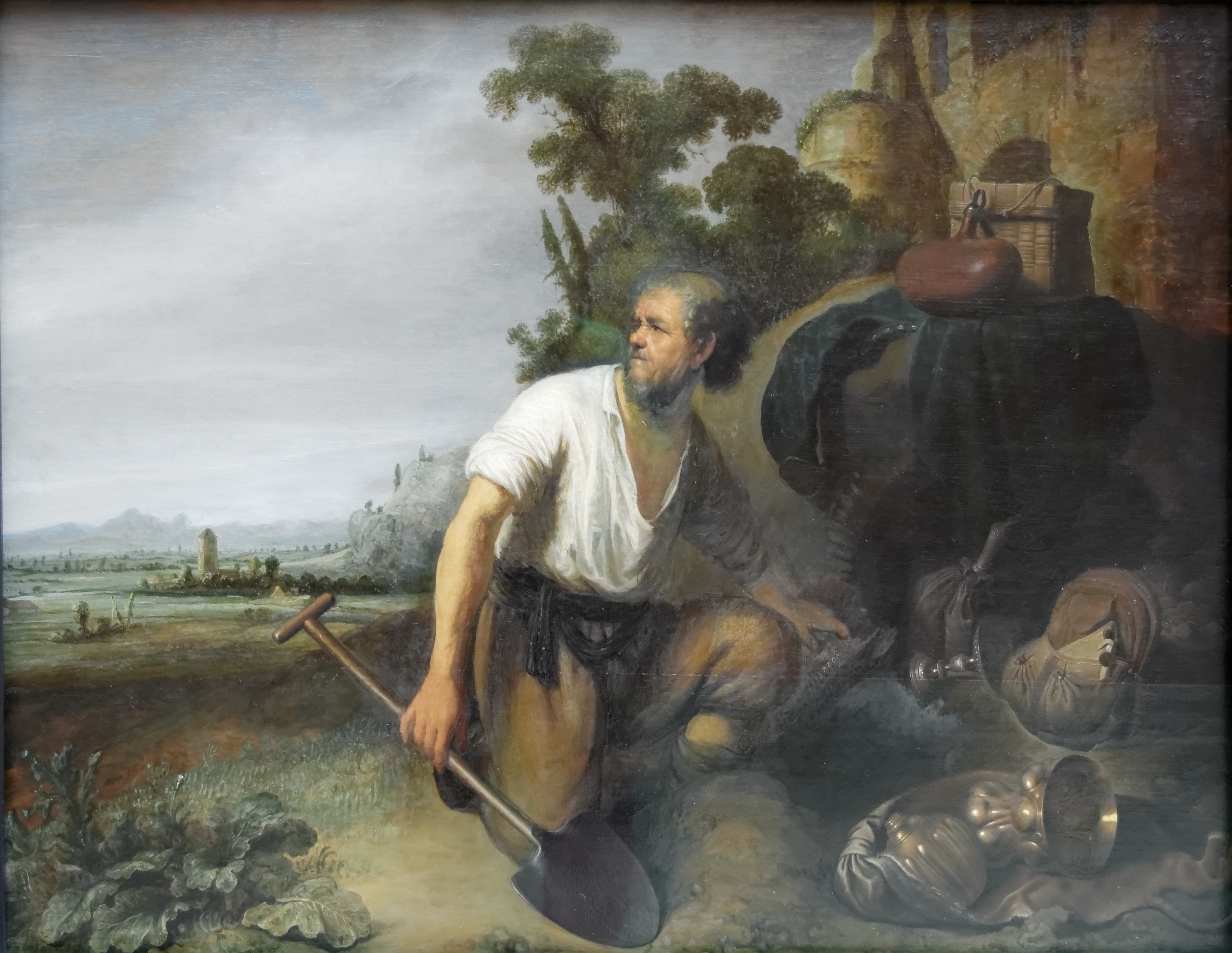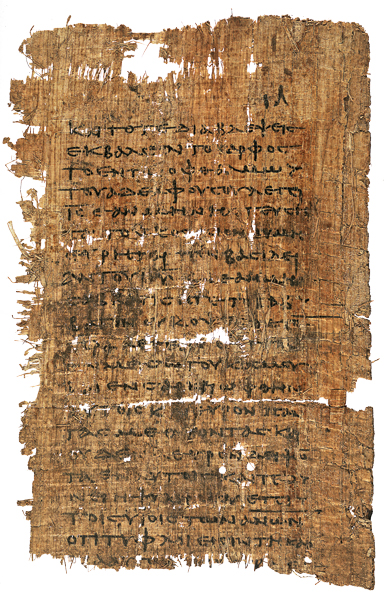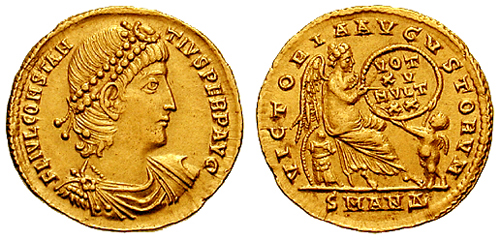|
Parable Of The Hidden Treasure
The Parable of the Hidden Treasure is a parable of Jesus which appears in Matthewbr>13:44and illustrates the great value of the Kingdom of Heaven. It immediately precedes the parable of the pearl, which has a similar theme. The parable has been depicted by artists such as Rembrandt. Narrative The brief parable of the hidden treasure is as follows: The setting presupposes that someone has buried a treasure. The current owner of the field is unaware of its existence. The finder is unable to conveniently extract it unless he buys the field. For a peasant, such a discovery of treasure represented the "ultimate dream."Craig S. Keener, A Commentary on the Gospel of Matthew', Eerdmans, 1999, , p. 391. Interpretation This parable is interpreted as illustrating the great value of the Kingdom of Heaven and thus has a similar theme to the parable of the pearl. John Nolland comments that the good fortune reflected in the "finding" reflects a "special privilege,"John Nolland, The Gos ... [...More Info...] [...Related Items...] OR: [Wikipedia] [Google] [Baidu] |
Parable Of The Hidden Treasure Rembrandt - Gerard Dou
A parable is a succinct, didactic story, in prose or verse, that illustrates one or more instructive lessons or principles. It differs from a fable in that fables employ animals, plants, inanimate objects, or forces of nature as characters, whereas parables have human characters. A parable is a type of metaphorical analogy. Some scholars of the canonical gospels and the New Testament apply the term "parable" only to the parables of Jesus, although that is not a common restriction of the term. Etymology The word ''parable'' comes from the Greek παραβολή (''parabolē''), literally "throwing" (''bolē'') "alongside" (''para-''), by extension meaning "comparison, illustration, analogy." It was the name given by Greek rhetoricians to an illustration in the form of a brief fictional narrative. History The Bible contains numerous parables in the Gospels of the New Testament ( Jesus' parables). These are believed by some scholars (such as John P. Meier) to have been inspired b ... [...More Info...] [...Related Items...] OR: [Wikipedia] [Google] [Baidu] |
Church Fathers
The Church Fathers, Early Church Fathers, Christian Fathers, or Fathers of the Church were ancient and influential Christian theologians and writers who established the intellectual and doctrinal foundations of Christianity. The historical period in which they worked became known as the Patristics, Patristic Era and spans approximately from the late 1st to mid-8th centuries, flourishing in particular during the 4th and 5th centuries, when Christianity was in the process of establishing itself as the State church of the Roman Empire, state church of the Roman Empire. For many denominations of Christianity, the writings of the Ante-Nicene Fathers, Nicene Fathers and Christianity in the 5th century#Post-Nicene Fathers, Post-Nicene Fathers are included in Sacred tradition, Sacred Tradition. As such, in traditional dogmatic theology, authors considered Church Fathers are treated as authoritative for the establishment of doctrine. The academic field of patristics, the study of the Chu ... [...More Info...] [...Related Items...] OR: [Wikipedia] [Google] [Baidu] |
James Tissot
Jacques Joseph Tissot (; 15 October 1836 – 8 August 1902), better known as James Tissot ( , ), was a French painter, illustrator, and caricaturist. He was born to a drapery merchant and a milliner and decided to pursue a career in art at a young age, coming to incorporate elements of realism (arts), realism, early Impressionism, and academic art into his work. He is best known for a variety of genre paintings of contemporary European high society produced during the peak of his career, which focused on the people and Victorian fashion, women's fashion of the Belle Époque and Victorian England, but he would also explore many medieval, bible, biblical, and ''japonisme, Japoniste'' subjects throughout his life. His career included work as a caricaturist for ''Vanity Fair (British magazine), Vanity Fair'' under the pseudonym of Coïdé. Tissot served in the Franco-Prussian War on the side of Second French Empire, France and later the Paris Commune. In 1871 he moved to London, wh ... [...More Info...] [...Related Items...] OR: [Wikipedia] [Google] [Baidu] |
Jan Luyken
Johannes or Jan Luyken (16 April 1649 – 5 April 1712) was a Dutch poet, illustrator, and engraving, engraver.Kort verhaal Van het godvruchtig leven En zalig afsterven Van Joannes Luiken (Short story of the religious life and peaceful death of Joannes Luiken) in the Digital library for Dutch literature, DBNL Biography  He was born and died in Amsterdam, where he learned engraving from his father Kaspa ...
He was born and died in Amsterdam, where he learned engraving from his father Kaspa ...
[...More Info...] [...Related Items...] OR: [Wikipedia] [Google] [Baidu] |
Parable - The Hidden Treasure - Sir John Everett Millais - ABDAG004395
A parable is a succinct, didactic story, in prose or verse, that illustrates one or more instructive lessons or principles. It differs from a fable in that fables employ animals, plants, inanimate objects, or forces of nature as characters, whereas parables have human characters. A parable is a type of metaphorical analogy. Some scholars of the canonical gospels and the New Testament apply the term "parable" only to the parables of Jesus, although that is not a common restriction of the term. Etymology The word ''parable'' comes from the Greek παραβολή (''parabolē''), literally "throwing" (''bolē'') "alongside" (''para-''), by extension meaning "comparison, illustration, analogy." It was the name given by Greek rhetoricians to an illustration in the form of a brief fictional narrative. History The Bible contains numerous parables in the Gospels of the New Testament ( Jesus' parables). These are believed by some scholars (such as John P. Meier) to have been inspired b ... [...More Info...] [...Related Items...] OR: [Wikipedia] [Google] [Baidu] |
Gospel Of Thomas
The Gospel of Thomas (also known as the Coptic Gospel of Thomas) is a non-canonical Logia, sayings gospel. It was discovered near Nag Hammadi, Egypt, in 1945 among a group of books known as the Nag Hammadi library. Scholars speculate the works were buried in response to a letter from Bishop Athanasius of Alexandria, Athanasius declaring a strict canon of Christian scripture. Most scholars place the composition during the second century, while some have proposed dates as late as 250 AD and others have traced its signs of origins back to 60 AD. Some scholars have seen it as evidence of the existence of a "Q source" that might have been similar in its form as a collection of sayings of Jesus, without any accounts of his deeds or his life and death, referred to as a sayings gospel, though most conclude that Thomas depends on or harmonizes the Synoptics. The Coptic language, Coptic-language text, the second of seven contained in what scholars have designated as Nag Hammadi ... [...More Info...] [...Related Items...] OR: [Wikipedia] [Google] [Baidu] |
Augustine Of Hippo
Augustine of Hippo ( , ; ; 13 November 354 – 28 August 430) was a theologian and philosopher of Berber origin and the bishop of Hippo Regius in Numidia, Roman North Africa. His writings deeply influenced the development of Western philosophy and Western Christianity, and he is viewed as one of the most important Church Fathers of the Latin Church in the Patristic Period. His many important works include '' The City of God'', '' On Christian Doctrine'', and '' Confessions''. According to his contemporary, Jerome of Stridon, Augustine "established anew the ancient Faith". In his youth he was drawn to the Manichaean faith, and later to the Hellenistic philosophy of Neoplatonism. After his conversion to Christianity and baptism in 386, Augustine developed his own approach to philosophy and theology, accommodating a variety of methods and perspectives. Believing the grace of Christ was indispensable to human freedom, he helped formulate the doctrine of original sin and m ... [...More Info...] [...Related Items...] OR: [Wikipedia] [Google] [Baidu] |
Pope Gregory I
Pope Gregory I (; ; – 12 March 604), commonly known as Saint Gregory the Great (; ), was the 64th Bishop of Rome from 3 September 590 until his death on 12 March 604. He is known for instituting the first recorded large-scale mission from Rome, the Gregorian mission, to convert the then largely pagan Anglo-Saxons to Christianity. Gregory is also well known for his writings, which were more prolific than those of any of his predecessors as pope. The epithet Saint Gregory the Dialogist has been attached to him in Eastern Christianity because of his '' Dialogues''. English translations of Eastern texts sometimes list him as Gregory "Dialogos" from the Greek (''dialogos'', conversation), or the Anglo-Latinate equivalent "Dialogus". He is the second of the three Popes listed in the ''Annuario Pontificio'' with the title "the Great", alongside Popes Leo I and Nicholas I. A Roman senator's son and himself the prefect of Rome at 30, Gregory lived in a monastery that he establish ... [...More Info...] [...Related Items...] OR: [Wikipedia] [Google] [Baidu] |
Jerome
Jerome (; ; ; – 30 September 420), also known as Jerome of Stridon, was an early Christian presbyter, priest, Confessor of the Faith, confessor, theologian, translator, and historian; he is commonly known as Saint Jerome. He is best known for his translation of the Bible into Latin (the translation that became known as the Vulgate) and his commentaries on the whole Bible. Jerome attempted to create a translation of the Old Testament based on a Hebrew version, rather than the Septuagint, as Vetus Latina, prior Latin Bible translations had done. His list of writings is extensive. In addition to his biblical works, he wrote polemical and historical essays, always from a theologian's perspective. Jerome was known for his teachings on Christian moral life, especially those in cosmopolitan centers such as Rome. He often focused on women's lives and identified how a woman devoted to Jesus should live her life. This focus stemmed from his close patron relationships with several pro ... [...More Info...] [...Related Items...] OR: [Wikipedia] [Google] [Baidu] |
Hilary Of Poitiers
Hilary of Poitiers (; ) was Bishop of Poitiers and a Doctor of the Church. He was sometimes referred to as the "Hammer of the Arians" () and the " Athanasius of the West". His name comes from the Latin word for happy or cheerful. In addition to his important work as bishop, Hilary was married and the father of Abra of Poitiers, a nun and saint who became known for her charity. Early life Hilary was born at Poitiers either at the end of the 3rd or beginning of the 4th century A.D. His parents were pagans of distinction. He received a good education, which included a high level of Greek. He studied, later on, the Old and New Testament writings, with the result that he abandoned his Neoplatonism for Christianity, and with his wife and his daughter, traditionally known as Saint Abra of Poitiers, was baptized and received into the Church. Arianism was becoming popular among Christians in this era and this theological position was supported by Constantine the Great. There were a ... [...More Info...] [...Related Items...] OR: [Wikipedia] [Google] [Baidu] |
John Chrysostom
John Chrysostom (; ; – 14 September 407) was an important Church Father who served as archbishop of Constantinople. He is known for his preaching and public speaking, his denunciation of abuse of authority by both ecclesiastical and political leaders, his '' Divine Liturgy of Saint John Chrysostom'', and his ascetic sensibilities. He was also the author of '' Adversus Judaeos'' and was strongly anti-Judaism. The epithet (''Chrysostomos'', anglicized as Chrysostom) means "golden-mouthed" in Greek and denotes his celebrated eloquence. Chrysostom was among the most prolific authors in the early Christian Church. He is honored as a saint in the Eastern Orthodox, Oriental Orthodox, Catholic, Anglican, and Lutheran churches, as well as in some others. The Eastern Orthodox, together with the Byzantine Catholics, hold him in special regard as one of the Three Holy Hierarchs (alongside Basil of Caesarea and Gregory of Nazianzus). Along with them and Athanasius of Alexa ... [...More Info...] [...Related Items...] OR: [Wikipedia] [Google] [Baidu] |
Teachings Of Jesus 10 Of 40
A school of thought, or intellectual tradition, is the perspective of a group of people who share common characteristics of opinion or outlook of a philosophy, discipline, belief, social movement, economics, cultural movement, or art movement. History The phrase has become a common colloquialism which is used to describe those that think alike or those that focus on a common idea. The term's use is common place. Schools are often characterized by their currency, and thus classified into "new" and "old" schools. There is a convention, in political and philosophical fields of thought, to have "modern" and "classical" schools of thought. An example is the modern and classical liberals. This dichotomy is often a component of paradigm shift. However, it is rarely the case that there are only two schools in any given field. Schools are often named after their founders such as the "Rinzai school" of Zen, named after Linji Yixuan; and the Asharite school of early Muslim philosophy, na ... [...More Info...] [...Related Items...] OR: [Wikipedia] [Google] [Baidu] |











